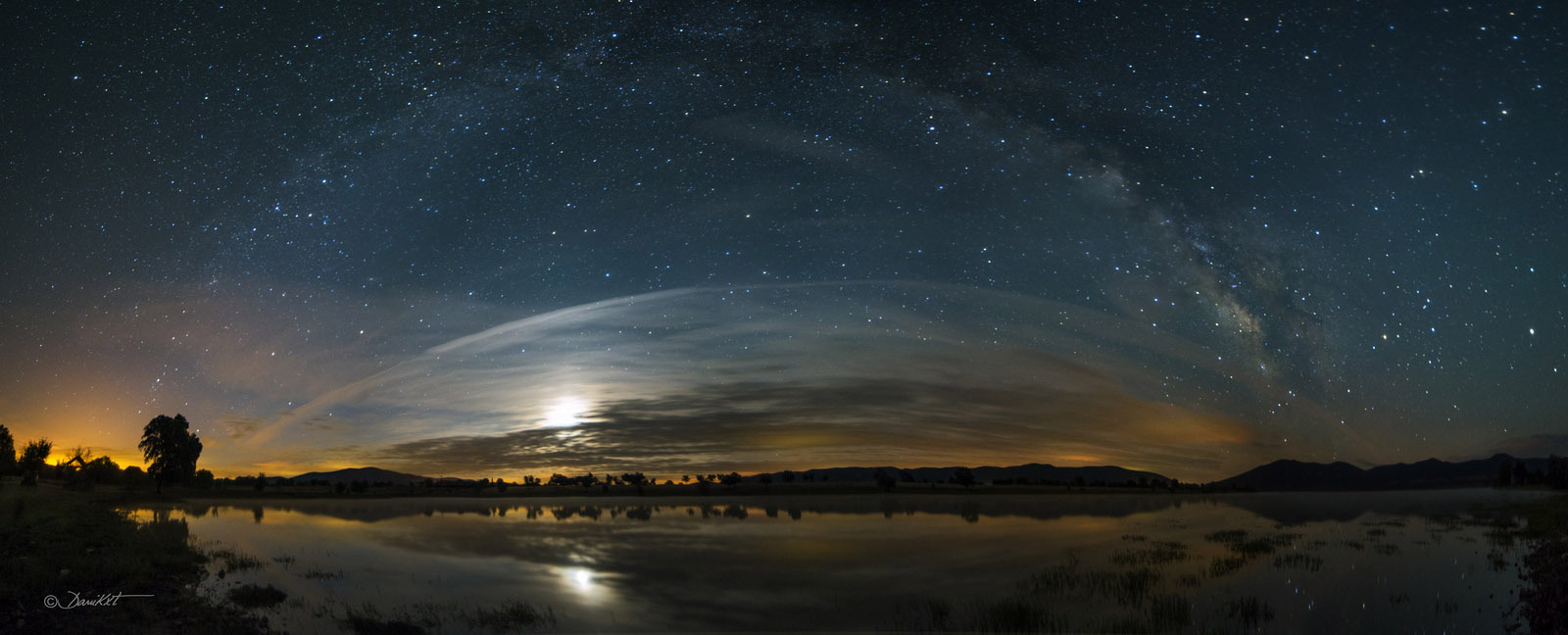Difference between revisions of "May 31, 2014"
| Line 3: | Line 3: | ||
<!-- ws:start:WikiTextHeadingRule:0:<h1> --> | <!-- ws:start:WikiTextHeadingRule:0:<h1> --> | ||
<!-- ws:start:WikiTextLocalImageRule:6:<img src="/file/view/LPOD-May31-14.jpg/512222134/LPOD-May31-14.jpg" alt="" title="" /> -->[[File:LPOD-May31-14.jpg|LPOD-May31-14.jpg]]<!-- ws:end:WikiTextLocalImageRule:6 --><br /> | <!-- ws:start:WikiTextLocalImageRule:6:<img src="/file/view/LPOD-May31-14.jpg/512222134/LPOD-May31-14.jpg" alt="" title="" /> -->[[File:LPOD-May31-14.jpg|LPOD-May31-14.jpg]]<!-- ws:end:WikiTextLocalImageRule:6 --><br /> | ||
| − | <em>image by [mailto:DANIKXT@telefonica.net | + | <em>image by [mailto:DANIKXT@telefonica.net Dani Caxete], Embalse Torre de Abraham-Toledo-Spain</em><br /> |
<br /> | <br /> | ||
The Moon and the Milky Way only seem likely to be in the same image if the Moon is a crescent; the Moon has to be enough days old not to be too near the Sun which would make the sky too bright to image the MW. And the Moon can't be too full or it would brighten the sky too much for the MW to be seen. In Dani's beautiful image, the Moon, whatever its phase, is near the horizon and diffused by low clouds, one of which arcs over like a thin Milky Way. Another condition required for this image is a dark and transparent sky so that the MW is recordable. At my location on Main Street in a small town, the limiting magnitude is about 3 due to sky brightness; the MW and most of the universe are not available from my back [http://lpod.wikispaces.com/September+14%2C+2012 deck]. That is why, one reason at least, I study the easily found Moon and the brighter planets. But the Moon is in the image and so this qualifies to be an LPOD, thankfully, for it is too gorgeous to forego.<br /> | The Moon and the Milky Way only seem likely to be in the same image if the Moon is a crescent; the Moon has to be enough days old not to be too near the Sun which would make the sky too bright to image the MW. And the Moon can't be too full or it would brighten the sky too much for the MW to be seen. In Dani's beautiful image, the Moon, whatever its phase, is near the horizon and diffused by low clouds, one of which arcs over like a thin Milky Way. Another condition required for this image is a dark and transparent sky so that the MW is recordable. At my location on Main Street in a small town, the limiting magnitude is about 3 due to sky brightness; the MW and most of the universe are not available from my back [http://lpod.wikispaces.com/September+14%2C+2012 deck]. That is why, one reason at least, I study the easily found Moon and the brighter planets. But the Moon is in the image and so this qualifies to be an LPOD, thankfully, for it is too gorgeous to forego.<br /> | ||
<br /> | <br /> | ||
| − | <em>[mailto:tychocrater@yahoo.com | + | <em>[mailto:tychocrater@yahoo.com Chuck Wood]</em><br /> |
| − | (Note: I'm waiting for the Moon to test some new [http://www.hayneedle.com/product/zhumelllongeyereliefeyepieces.cfm?redirect=false&source=pla&kwid=Telescope%20Accessories_ZHUI022&tid=ZHUI022&adtype=pla&kw=&ci_src=17588969&ci_sku=ZHUI022&gclid=COKdn8j61L4CFYMGOgodZAcAJw | + | (Note: I'm waiting for the Moon to test some new [http://www.hayneedle.com/product/zhumelllongeyereliefeyepieces.cfm?redirect=false&source=pla&kwid=Telescope%20Accessories_ZHUI022&tid=ZHUI022&adtype=pla&kw=&ci_src=17588969&ci_sku=ZHUI022&gclid=COKdn8j61L4CFYMGOgodZAcAJw eyepieces] I just bought. They are cheap but have good reviews; I'll see in the next few days, clouds permitting.)<br /> |
<br /> | <br /> | ||
<strong>Technical Details</strong><br /> | <strong>Technical Details</strong><br /> | ||
| Line 14: | Line 14: | ||
<br /> | <br /> | ||
<strong>Related Links</strong><br /> | <strong>Related Links</strong><br /> | ||
| − | Dani's [http://www.flickr.com/photos/danicaxete/with/8288269706/ | + | Dani's [http://www.flickr.com/photos/danicaxete/with/8288269706/ space photos]<br /> |
<br /> | <br /> | ||
<hr /> | <hr /> | ||
Revision as of 20:08, 17 January 2015
M & M

image by Dani Caxete, Embalse Torre de Abraham-Toledo-Spain
The Moon and the Milky Way only seem likely to be in the same image if the Moon is a crescent; the Moon has to be enough days old not to be too near the Sun which would make the sky too bright to image the MW. And the Moon can't be too full or it would brighten the sky too much for the MW to be seen. In Dani's beautiful image, the Moon, whatever its phase, is near the horizon and diffused by low clouds, one of which arcs over like a thin Milky Way. Another condition required for this image is a dark and transparent sky so that the MW is recordable. At my location on Main Street in a small town, the limiting magnitude is about 3 due to sky brightness; the MW and most of the universe are not available from my back deck. That is why, one reason at least, I study the easily found Moon and the brighter planets. But the Moon is in the image and so this qualifies to be an LPOD, thankfully, for it is too gorgeous to forego.
Chuck Wood
(Note: I'm waiting for the Moon to test some new eyepieces I just bought. They are cheap but have good reviews; I'll see in the next few days, clouds permitting.)
Technical Details
Panorama of 7 photos. 30 sec. f/2.8, 3200 ISO
Related Links
Dani's space photos



